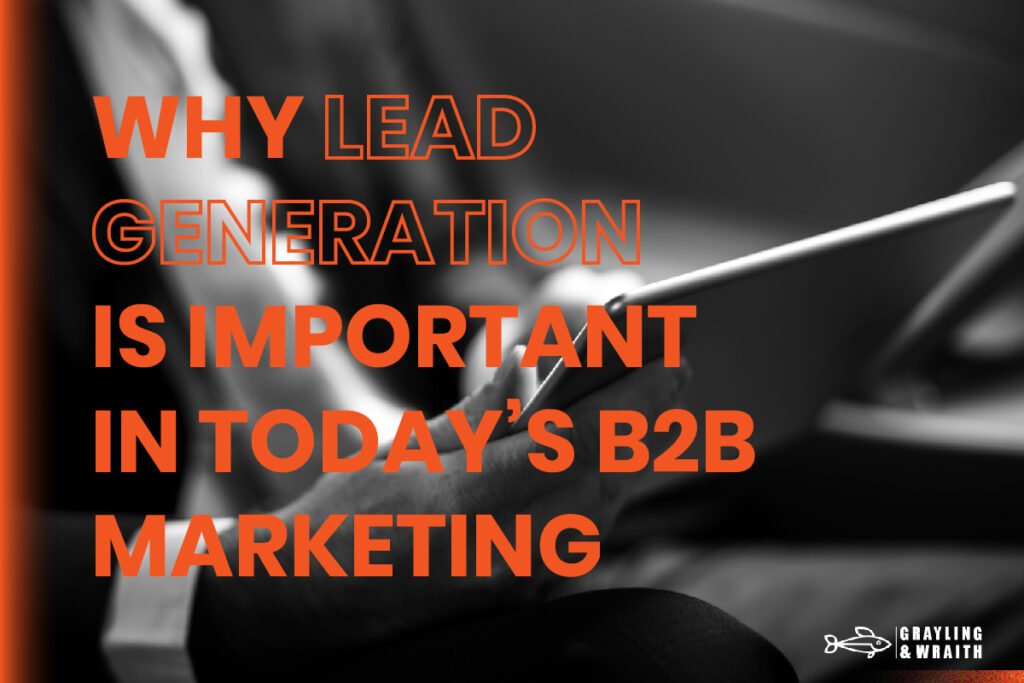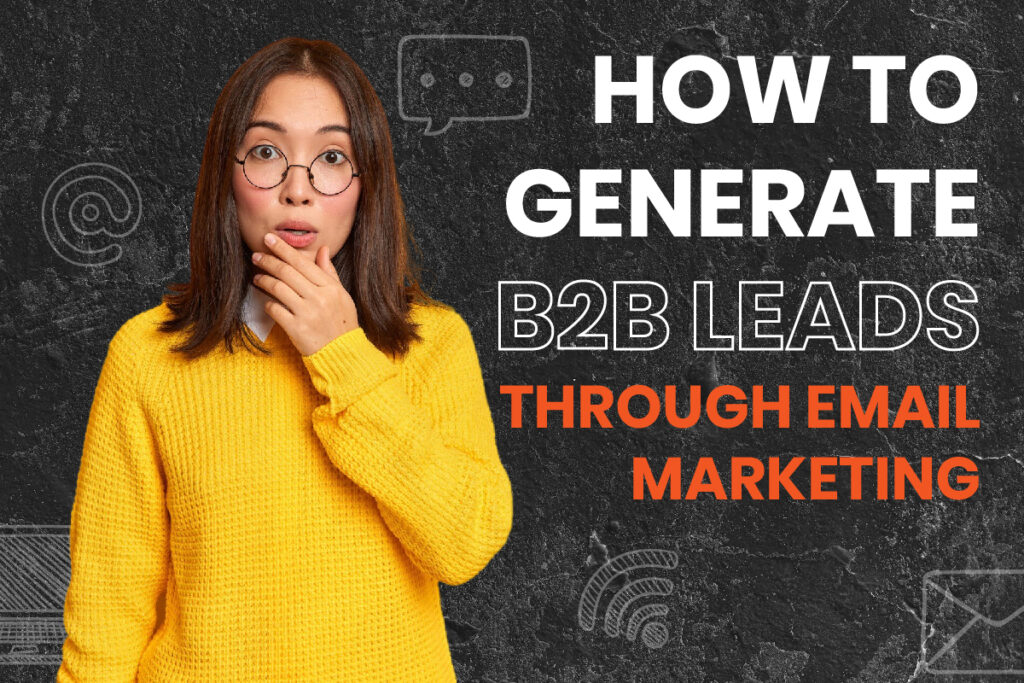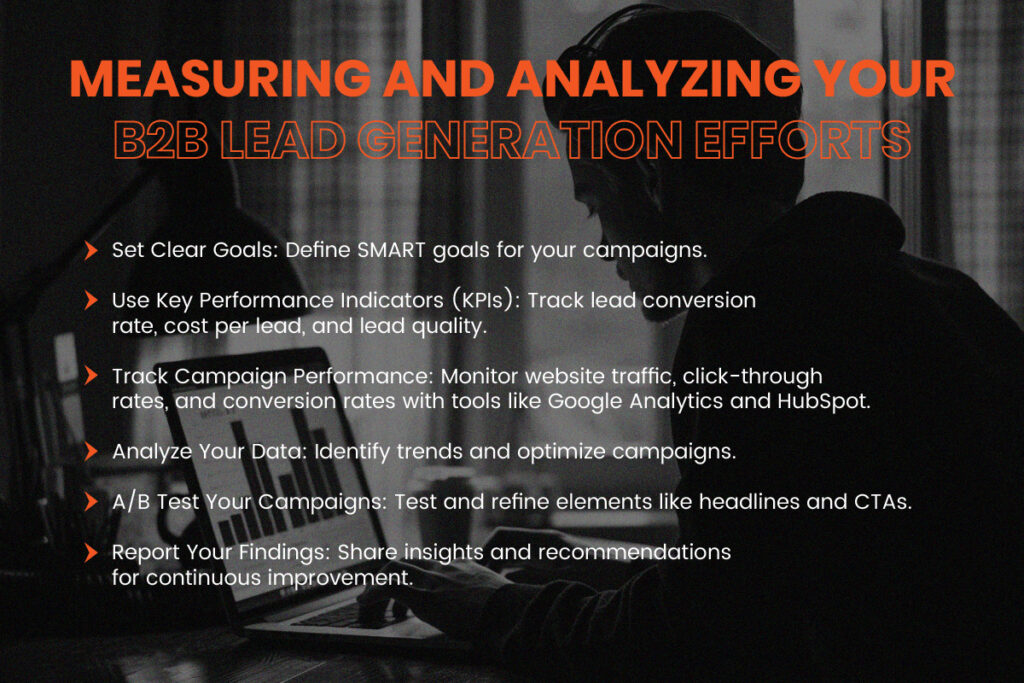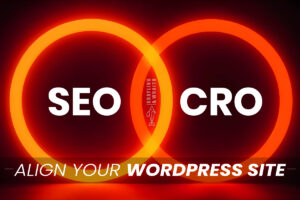In the competitive world of B2B marketing, lead generation is crucial for business growth. Therefore, our team specializes in developing and implementing effective B2B lead-generation strategies tailored to your needs. In this article, we will guide you through the essential aspects of B2B lead generation, showcasing how our comprehensive services can help your business succeed. By understanding and applying these strategies, you can gain a competitive edge and drive sustained growth for your company.
What is B2B Lead Generation?
B2B lead generation refers to identifying and attracting potential business clients for your products or services. Unlike B2C (business-to-consumer), B2B transactions involve selling products or services to other businesses. This multi-faceted process includes:
- Identifying potential clients.
- Engaging with them through various marketing channels.
- Nurturing these prospects until they are ready to make a purchasing decision.
We excel in building relationships with key decision-makers within target companies. Additionally, our approach combines marketing and sales efforts, ensuring a seamless and collaborative lead-generation process. Furthermore, we leverage our expertise to understand your potential client’s needs and pain points, crafting tailored solutions that resonate with them.
The process begins with thorough market research to identify the industries and companies that would benefit most from your offerings. Moreover, this research involves analyzing market trends, competitor strategies, and the specific needs and challenges of potential clients. By understanding these factors, we can develop targeted marketing messages that speak directly to your audience’s pain points and demonstrate how your products or services can provide effective solutions.
Once potential clients are identified, we engage with them through a variety of marketing channels, including email campaigns, social media, content marketing, and direct outreach. Each interaction is designed to build trust and establish your company as a credible and reliable partner. This engagement is not just about promoting your products or services but also about providing value through informative and educational content that helps potential clients solve their problems and achieve their goals.
Nurturing these prospects is a critical component of B2B lead generation. This involves maintaining regular communication, offering personalized content, and addressing any questions or concerns they may have. By nurturing leads over time, we ensure they remain engaged and interested in your offerings, increasing the likelihood of conversion when they are ready to make a purchasing decision.

The Importance of B2B Lead Generation
Effective B2B lead generation is essential for sustainable business growth. Here’s how our services can help you achieve this:
- Increasing Sales Opportunities: By identifying and engaging with potential clients, we increase the number of opportunities for your sales team to close deals. In fact, each lead represents a possible sale, and our targeted approach ensures that these leads are high-quality and more likely to convert. Consequently, this maximizes your sales team’s efficiency and boosts overall business growth.
- Building a Robust Sales Pipeline: Our strategies ensure a steady stream of qualified leads, thereby providing a consistent flow of potential clients for your sales team. Indeed, a healthy sales pipeline is crucial for maintaining business momentum and achieving long-term growth. With this approach, you can sustain a competitive edge and continuously drive your business forward.
- Enhancing Brand Awareness: We engage with potential clients through various marketing channels, thereby increasing awareness of your brand and its offerings, and establishing your company as a thought leader. As a result, this increased visibility can lead to more inbound inquiries and organic lead generation. By leveraging multiple channels, we ensure a broader reach and higher engagement with your target audience.
- Establishing Long-Term Client Relationships: Our approach is not just about making sales; it’s about building relationships. We nurture leads and provide value at every stage of the buyer’s journey, developing long-term relationships with your clients. These relationships can lead to repeat business, referrals, and long-term partnerships that benefit both parties.
The importance of B2B lead generation cannot be overstated. In today’s competitive business environment, companies that effectively generate and nurture leads have a significant advantage. By consistently identifying and engaging with potential clients, businesses can ensure a steady flow of new opportunities, crucial for achieving sustainable growth.
Our dedicated team of experts specializes in creating effective lead-generation strategies tailored to your unique needs. Visit our Grayling and Wraith to learn more about how we can assist you in achieving your business goals.
Developing a B2B Lead Generation Strategy
Creating an effective B2B lead generation strategy involves several key steps. Here’s how we develop a successful strategy:
Understanding Your Target Audience
To generate high-quality leads, it’s crucial to understand your target audience. To begin with, start by identifying the industries, companies, and decision-makers that would benefit from your offerings. This, in turn, involves market research and analysis to identify potential clients’ needs, pain points, and challenges. By doing so, you can tailor your approach to effectively address their specific requirements.
Understanding your target audience allows you to tailor your marketing messages to resonate with them. This personalized approach can significantly increase the effectiveness of your lead-generation efforts. Here are some steps to better understand your target audience:
- Conduct Market Research: Use surveys, interviews, and other research methods to gather information about your target audience. Understand their needs, preferences, and pain points.
- Surveys and Questionnaires: These can be distributed via email or social media to gather insights directly from your target audience. Furthermore, questions should be designed to uncover their biggest challenges, goals, and preferences.
- Interviews: Conducting one-on-one interviews with existing clients or prospects can provide deeper insights into their needs and decision-making processes.
- Industry Reports: Utilize reports and studies published by industry analysts to gain a broader understanding of market trends and dynamics.
- Analyze Your Competitors: Study your competitors to understand who their clients are and what strategies they are using. This can provide valuable insights into your target audience.
- Competitive Analysis: First, identify your main competitors and analyze their marketing strategies, content, and customer base. Next, look for gaps or opportunities that your business can exploit. By doing so, you can develop a competitive edge and position your offerings more effectively in the market.
- Social Media Monitoring: Observe how competitors engage with their audience on social media. This can reveal popular topics, concerns, and feedback from their followers.
- Segment Your Audience: Divide your target audience into different segments based on factors such as industry, company size, and decision-maker roles. This allows you to create more personalized and effective marketing messages for each segment.
- Demographic Segmentation: Group your audience by characteristics such as age, gender, income, and education level.
- Firmographic Segmentation: Segment based on company characteristics like industry, company size, revenue, and location.
- Behavioral Segmentation: Consider factors such as purchasing behavior, product usage, and brand loyalty.
By understanding your target audience, you can create highly targeted marketing campaigns that address the specific needs and pain points of potential clients. Consequently, this increases the likelihood of attracting high-quality leads and converting them into customers. As a result, your marketing efforts become more efficient and effective, leading to better overall business outcomes.
Creating Buyer Personas
Buyer personas are detailed profiles of your ideal customers. They help tailor your marketing messages to resonate with specific audience segments. Creating accurate and detailed buyer personas involves:
- Collecting Data: Gather data from various sources, such as your CRM, website analytics, and customer feedback. Specifically, this data should include demographic information, job roles, company size, industry, and other relevant details. By consolidating this information, you can gain valuable insights into your target audience and refine your marketing strategies accordingly.
- CRM Data: Analyze your customer relationship management (CRM) system to identify patterns and trends in your customer base.
- Website Analytics: Use tools like Google Analytics to understand how visitors interact with your website, what content they engage with, and their journey through your site.
- Customer Feedback: Collect feedback through surveys, reviews, and direct interactions to gain insights into customer satisfaction and needs.
- Identifying Common Traits: Look for common traits and patterns among your existing clients and leads. This can help you identify key characteristics that define your ideal customers.
- Cluster Analysis: Use statistical methods to identify clusters or groups within your customer data that share similar characteristics.
- Pattern Recognition: Identify recurring themes or traits in customer feedback and behavior.
- Developing Detailed Profiles: Create detailed profiles that include information about your ideal customers’ needs, pain points, goals, and challenges. Use this information to create personalized marketing messages that resonate with each persona.
- Persona Templates: Develop templates that outline key details for each persona, such as demographics, job roles, goals, challenges, preferred communication channels, and content preferences.
- Storytelling: Create narratives or stories for each persona to humanize them and make it easier for your team to relate to and understand their needs.
Creating detailed buyer personas helps you understand your target audience’s motivations and decision-making processes. With this insight, you can create more effective marketing campaigns that address the specific needs and challenges of each persona, thereby increasing the likelihood of attracting and converting high-quality leads. Ultimately, this strategic approach ensures that your marketing efforts resonate with your audience, leading to better engagement and higher conversion rates.

Leveraging Content Marketing for B2B Leads
Content marketing is a powerful tool for B2B lead generation. By consistently providing valuable content, you can attract and engage potential clients. In essence, content marketing involves creating and distributing valuable, relevant, and consistent content to attract and retain a clearly defined audience. As a result, this approach helps build trust and authority, making it more likely that potential clients will choose your business over competitors.
Blogging and Articles
Regularly publishing blog posts and articles on topics relevant to your industry can establish your company as a thought leader. Ensure your content is SEO-optimized to increase visibility. Here are some tips for effective blogging and article writing:
- Identify Relevant Topics: Use keyword research tools to identify topics that are relevant to your target audience and have high search volumes. Focus on topics that address your audience’s pain points and challenges.
- Keyword Research: Tools like Google Keyword Planner, Ahrefs, and SEMrush can help identify high-volume keywords and trending topics.
- Audience Feedback: Pay attention to common questions or issues raised by your audience through surveys, social media, and customer service interactions.
- Create High-Quality Content: Ensure your content is well-researched, informative, and engaging. Use a mix of text, images, and videos to keep your audience engaged.
- Research and Sources: Use credible sources to back up your claims and provide valuable insights. Incorporate data, statistics, and case studies to add depth to your content.
- Visual Elements: Enhance your content with images, infographics, videos, and charts to make it more engaging and easier to understand.
- Optimize for SEO: Use relevant keywords throughout your content to improve its search engine ranking. Include keywords in your headings, subheadings, and meta descriptions.
- On-Page SEO: Optimize your titles, meta descriptions, headers, and image alt texts with target keywords.
- Internal Linking: Link to other relevant content on your website to improve navigation and boost SEO.
- Promote Your Content: Share your blog posts and articles on social media, email newsletters, and other marketing channels to increase your reach and visibility.
- Social Media: Use platforms like LinkedIn, Twitter, and Facebook to share your content and engage with your audience.
- Email Marketing: Include links to your latest blog posts in your email newsletters to drive traffic and engagement.
- Guest Posting: Contribute articles to industry publications and blogs to reach a broader audience and build backlinks.
Blogging and articles can drive significant traffic to your website and generate high-quality leads. By consistently publishing valuable content, you can establish your company as a trusted source of information and build credibility with your target audience.
Ebooks and Whitepapers
Offering in-depth content like ebooks and whitepapers can help capture leads. Visitors are often willing to provide their contact information in exchange for valuable resources. Here are some steps to create effective ebooks and whitepapers:
- Choose a Relevant Topic: Select a topic that addresses a specific pain point or challenge faced by your target audience. Ensure the topic is relevant and valuable.
- Topic Selection: Use your market research and audience insights to identify pressing issues and challenges that your audience faces.
- Trend Analysis: Monitor industry trends and emerging topics to stay ahead and provide timely content.
- Conduct Thorough Research: Gather data and information from credible sources to create a well-researched and informative ebook or whitepaper.
- Data Collection: Use primary research (surveys, interviews) and secondary research (industry reports, academic studies) to gather comprehensive data.
- Expert Contributions: Collaborate with industry experts to provide insights and validate your findings.
- Create Engaging Content: Use a mix of text, images, charts, and graphs to make your content engaging and easy to understand. Ensure your content provides actionable insights and solutions.
- Content Structure: Organize your content into clear sections with headings, subheadings, and bullet points for easy navigation.
- Design Elements: Use professional design tools to create visually appealing layouts that enhance readability.
- Promote Your Content: Use landing pages, email marketing, and social media to promote your ebooks and whitepapers. Offer them as gated content, requiring visitors to provide their contact information to access the content.
- Landing Pages: Create dedicated landing pages with persuasive copy and clear calls to action to encourage downloads.
- Email Campaigns: Send targeted email campaigns to your subscriber list, highlighting the value of your ebook or whitepaper.
- Social Media Advertising: Use paid ads on platforms like LinkedIn to reach a broader audience and drive downloads.
Ebooks and whitepapers can position your company as an industry expert and provide valuable insights to your target audience. By offering these resources, you can capture high-quality leads and build a database of potential clients for future marketing efforts. Furthermore, this strategy helps establish credibility and trust, ultimately enhancing your company’s reputation in the industry. In turn, this can lead to increased engagement and higher conversion rates.

Utilizing Social Media for B2B Lead Generation
Social media platforms can be highly effective for B2B lead generation. Here’s how we can help you leverage social media:
LinkedIn Marketing
LinkedIn is the go-to platform for B2B marketers. Our approach includes:
- Optimize Your Profile: Ensure your LinkedIn profile is complete and professional, including a clear description of your business, your offerings, and your contact information.
- Profile Optimization: Include a professional headshot, a compelling headline, and a detailed summary of your experience and expertise.
- Company Page: Create and optimize your company page with relevant information, keywords, and engaging visuals.
- Join and Participate in Groups: Join LinkedIn groups relevant to your industry and actively participate in discussions, sharing valuable insights and engaging with group members.
- Group Engagement: Contribute to group discussions by sharing your knowledge, answering questions, and posting valuable content.
- Networking: Connect with other group members to build relationships and expand your network.
- Share Valuable Content: Regularly share blog posts, articles, and other valuable content on your LinkedIn profile, using relevant hashtags to increase the reach of your content.
- Content Sharing: Post a mix of original content, industry news, and third-party articles to keep your audience engaged.
- Hashtag Strategy: Use relevant hashtags to increase the visibility of your posts and reach a broader audience.
- Engage with Your Audience: Respond to comments and messages promptly, engaging with your audience by asking questions and starting conversations.
- Commenting: Respond to comments on your posts and engage in discussions to build relationships with your audience.
- Direct Messaging: Use LinkedIn’s messaging feature to connect with prospects and start conversations.
Our LinkedIn marketing services help you connect with key decision-makers and industry professionals, build relationships with potential clients, and establish your company as a thought leader.
Twitter and Facebook
While LinkedIn is the primary platform, Twitter and Facebook can also drive traffic to your website and generate leads. Our strategy includes:
- Optimize Your Profiles: Ensure your Twitter and Facebook profiles are complete and professional, including a clear description of your business, your offerings, and your contact information.
- Profile Details: Include a professional profile picture, a compelling bio, and relevant links to your website and other social media profiles.
- Visual Branding: Use consistent branding elements such as logos, colors, and cover photos to create a cohesive online presence.
- Share Valuable Content: Regularly share blog posts, articles, and other valuable content on your Twitter and Facebook profiles, using relevant hashtags to increase the reach of your content.
- Content Calendar: Develop a content calendar to plan and schedule your posts in advance.
- Content Mix: Share a variety of content types, including blog posts, infographics, videos, and live streams.
- Engage with Your Audience: Respond to comments and messages promptly, engaging with your audience by asking questions and starting conversations.
- Real-Time Engagement: Monitor your social media accounts regularly to respond to comments and messages in real time.
- Polls and Surveys: Use polls and surveys to engage your audience and gather feedback.
- Run Paid Campaigns: Use Twitter and Facebook ads to reach a larger audience, targeting your ads based on factors such as industry, job role, and interests.
- Ad Targeting: Use advanced targeting options to reach specific audience segments based on demographics, interests, and behaviors.
- Ad Formats: Experiment with different ad formats such as promoted tweets, carousel ads, and video ads to see what resonates best with your audience.
Our Twitter and Facebook marketing services complement your LinkedIn efforts, reaching a broader audience and driving traffic to your website.

Email Marketing for B2B Lead Generation
Email marketing remains one of the most effective channels for B2B lead generation. Our email marketing strategy includes:
Building an Email List
Start by building a high-quality email list. Our approach involves:
- Create Lead Magnets: Offer valuable resources such as ebooks, whitepapers, and webinars in exchange for email addresses, ensuring our lead magnets address specific pain points and challenges faced by your target audience.
- Value Proposition: Communicate the value of your lead magnets and how they can help your audience solve their problems.
- Multiple Formats: Offer lead magnets in various formats (e.g., checklists, templates, guides) to appeal to different preferences.
- Use Opt-In Forms: Place opt-in forms on your website, blog, and landing pages, making it easy for visitors to subscribe by keeping the forms straightforward.
- Form Placement: Place opt-in forms in strategic locations such as the homepage, blog posts, and pop-ups to capture email addresses.
- Form Design: Use clear and compelling copy, eye-catching visuals, and minimal form fields to increase conversion rates.
- Promote Your Email List: Use social media, blog posts, and other marketing channels to promote your email list, highlighting the benefits of subscribing and providing clear calls to action.
- Social Media Promotion: Share links to your opt-in forms on your social media profiles and encourage followers to subscribe.
- Blog CTAs: Include calls-to-action (CTAs) in your blog posts to encourage readers to join your email list.
- Partnerships: Collaborate with industry influencers and partners to promote your email list and reach a wider audience.
A high-quality email list is the foundation of a successful email marketing campaign. Our strategies ensure you build a database of engaged and interested leads.
Crafting Compelling Emails
Our emails are personalized and provide value to the recipients. We focus on:
- Personalize Your Emails: Use the recipient’s name and personalize the content based on their interests and preferences, as personalized emails have higher open and click-through rates.
- Segmentation: Segment your email list based on criteria such as industry, job role, and engagement level to deliver relevant content.
- Dynamic Content: Use dynamic content blocks to tailor email content based on the recipient’s preferences and behavior.
- Create Engaging Subject Lines: Craft engaging and relevant subject lines, using action-oriented language and highlighting the value of the email.
- A/B Testing: Test different subject lines to determine which ones resonate best with your audience.
- Urgency and Curiosity: Use elements of urgency, curiosity, and personalization to capture attention.
- Provide Valuable Content: Ensure your emails provide valuable information that addresses the recipient’s needs and challenges, using a mix of text, images, and links to keep your content engaging.
- Content Variety: Include a mix of educational content, industry news, case studies, and promotional offers.
- Visual Appeal: Use high-quality images, infographics, and videos to enhance the visual appeal of your emails.
- Include Clear Calls-to-Action: Encourage recipients to take action by including clear calls-to-action in your emails, using action-oriented language, and making it easy for recipients to take the next step.
- CTA Placement: Place CTAs in prominent locations within your emails to increase click-through rates.
- Multiple CTAs: Use multiple CTAs throughout your email to cater to different preferences and increase the likelihood of engagement.
Our email marketing services nurture leads through the sales funnel, providing valuable information and building relationships with potential clients.
Leveraging Webinars and Virtual Events
Webinars and virtual events are excellent tools for engaging with potential leads. Our approach includes:
Planning and Promoting Your Webinar
Choose a relevant topic and promote your webinar across various channels. Our process involves:
- Choose a Relevant Topic: Select a topic that addresses a specific pain point or challenge faced by your target audience, ensuring the topic is relevant and valuable.
- Audience Insights: Use your buyer personas and audience insights to identify topics that will resonate with your audience.
- Expert Speakers: Invite industry experts and thought leaders to speak at your webinar to add credibility and attract a larger audience.
- Create Engaging Content: Develop a presentation that provides valuable insights and actionable solutions, using a mix of slides, videos, and live demonstrations to keep your audience engaged.
- Interactive Elements: Incorporate interactive elements such as polls, Q&A sessions, and live chats to engage your audience.
- Multimedia: Use a variety of multimedia elements to make your presentation more engaging and visually appealing.
- Promote Your Webinar: Use email marketing, social media, and your website to promote your webinar, creating a landing page with a registration form and providing clear calls-to-action to encourage sign-ups.
- Promotion Strategy: Develop a comprehensive promotion strategy that includes email campaigns, social media posts, and paid advertising.
- Countdown Timers: Use countdown timers in your promotional materials to create a sense of urgency and encourage registrations.
- Send Reminders: Send reminder emails to registered attendees leading up to the webinar, including details about the webinar, the agenda, and any additional resources.
- Reminder Sequence: Send a series of reminder emails (e.g., one week before, one day before, and one hour before) to ensure attendees don’t forget about the event.
- Value Highlights: Include highlights of what attendees can expect to learn and how the webinar will benefit them.
Our webinar planning and promotion services ensure you attract a large audience and generate high-quality leads.
Engaging Your Audience
During the webinar, provide valuable insights and engage with the audience through Q&A sessions. Our approach includes:
- Start with a Strong Introduction: Begin your webinar with a brief introduction that outlines the agenda and sets the stage for the presentation.
- Welcome Message: Welcome attendees, introduce the speakers, and provide an overview of the webinar’s objectives.
- Housekeeping: Explain how attendees can participate (e.g., asking questions, using chat features) and any technical details.
- Encourage Interaction: Encourage audience interaction by asking questions, conducting polls, and responding to comments, using interactive features to keep your audience engaged.
- Live Polls: Use live polls to gather audience feedback and make the webinar more interactive.
- Q&A Sessions: Allocate time for Q&A sessions to address attendees’ questions and concerns.
- Provide Actionable Insights: Ensure your presentation provides actionable insights and solutions that address the audience’s needs and challenges, using real-life examples and case studies to illustrate your points.
- Case Studies: Share real-life case studies and success stories to demonstrate the effectiveness of your solutions.
- Action Steps: Provide clear action steps that attendees can implement after the webinar.
- Follow Up with Attendees: Send follow-up emails to attendees after the webinar, including a summary of the presentation, additional resources, and a call-to-action to encourage further engagement.
- Follow-Up Content: Include a recording of the webinar, slides, and any additional resources mentioned during the presentation.
- Next Steps: Provide clear next steps, such as booking a consultation or downloading additional resources.
Our webinar services help build relationships and nurture leads, providing valuable insights and creating a memorable experience for your audience.

Measuring and Analyzing Your B2B Lead Generation Efforts
It’s essential to track and analyze your lead generation efforts to understand what’s working and what needs improvement. Our process includes:
- Set Clear Goals: Define clear goals and objectives for your lead generation campaigns, ensuring your goals are specific, measurable, achievable, relevant, and time-bound (SMART).
- Goal Setting: Set both short-term and long-term goals for your lead generation efforts, such as increasing website traffic, generating more qualified leads, and improving conversion rates.
- Alignment: Ensure your goals align with your overall business objectives and sales targets.
- Use Key Performance Indicators (KPIs): Identify key performance indicators (KPIs) to measure the success of your lead generation efforts, including lead conversion rate, cost per lead, and lead quality.
- KPIs Selection: Choose KPIs that are relevant to your goals and provide insights into the effectiveness of your strategies.
- Benchmarking: Establish benchmarks for your KPIs to track progress and measure success over time.
- Track Campaign Performance: Use analytics tools to track the performance of your lead generation campaigns, monitoring metrics such as website traffic, click-through rates, and conversion rates.
- Analytics Tools: Use tools like Google Analytics, HubSpot, and Salesforce to monitor and analyze your campaign performance.
- Dashboards: Create customized dashboards to visualize your data and track key metrics in real-time.
- Analyze Your Data: Analyze your data to identify trends, patterns, and areas for improvement, using this information to optimize your campaigns and improve your lead generation efforts.
- Data Analysis: Use advanced data analysis techniques to uncover insights and trends in your data.
- Continuous Improvement: Implement a continuous improvement process to regularly review and optimize your lead generation strategies.
- A/B Test Your Campaigns: Conduct A/B tests to compare different elements of your campaigns, such as headlines, calls-to-action, and email subject lines, using the results to identify the most effective strategies.
- Test Planning: Develop a testing plan that outlines what elements you will test, how you will measure success, and how you will implement the results.
- Iterative Testing: Continuously test and refine your campaigns to improve performance and achieve better results.
- Report Your Findings: Create regular reports to summarize your findings and share them with your team, using these reports to inform your decision-making and strategy development.
- Reporting Templates: Use standardized reporting templates to ensure consistency and clarity in your reports.
- Actionable Insights: Include actionable insights and recommendations in your reports to guide future strategy development.
Measuring and analyzing your lead generation efforts is crucial for continuous improvement. To this end, our comprehensive analytics and reporting services ensure your lead-generation campaigns are as effective as possible and that you are continuously improving your strategies.
Conclusion: Driving Business Success with Expert B2B Lead Generation
B2B lead generation is a dynamic and ongoing process that requires strategic planning and execution. By leveraging the strategies outlined in this article, you can drive significant business growth and build a robust sales pipeline. Ultimately, these efforts will position your company for long-term success in a competitive market. Our specialized B2B Lead Generation service is designed to help your business thrive. To discover how we can support your growth, visit Grayling and Wraith and explore our comprehensive solutions.

















